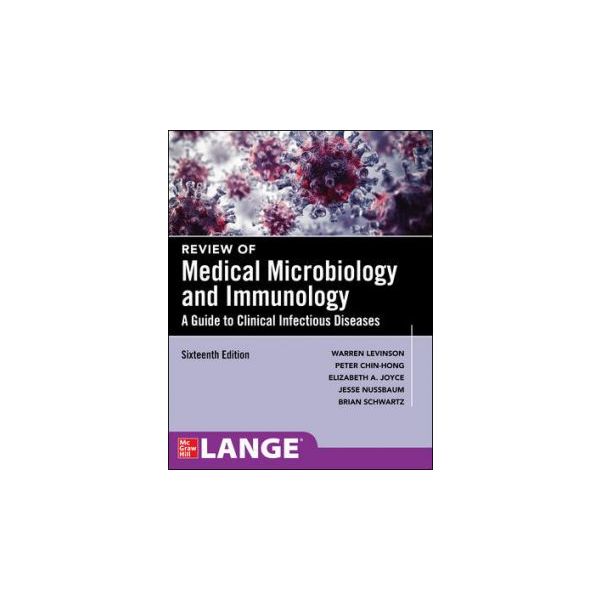REVIEW OF MEDICAL MICROBIOLOGY AND IMMUNOLOGY, 16E
The most concise, clinically relevant, and current review of medical microbiology and immunology
Review of Medical Microbiology and Immunology is a succinct, high-yield review of the medically important aspects of microbiology and immunology. It covers both the basic and clinical aspects of bacteriology, virology, mycology, parasitology, and immunology and also discusses important infectious diseases using an organ system approach. The book emphasizes the real-world clinical application of microbiology and immunology to infectious diseases and offers a unique mix of narrative text, color images, tables and figures, Q&A, and clinical vignettes.
• Content is valuable to any study objective or learning style
• Essential for USMLE review and medical microbiology coursework
• 650 USMLE-style practice questions test your knowledge and understanding
• 50 clinical cases illustrate the importance of basic science information in clinical diagnosis
• A complete USMLE-style practice exam consisting of 80 questions helps you prepare for the exam
• Pearls impart important basic science information helpful in answering questions on the USMLE
• Concise summaries of medically important organisms
• Self-assessment questions with answers appear at the end of each chapter
• Color images depict clinically important findings, such as infectious disease lesions
• Gram stains of bacteria, electron micrographs of viruses, and microscopic images depict fungi, protozoa, and worms
• Chapters on infectious diseases from an organ system perspective
| Author | LEVINSON |
|---|---|
| Table Of Content | • Part 1……Bacteriologyo Chapter 1: Bacteria Compared With Other Microorganisms o Chapter 2: Structure of Bacterial Cells o Chapter 3: Growth o Chapter 4: Genetics o Chapter 5: Classification of Medically Important Bacteria o Chapter 6: The Human Microbiome o Chapter 7: Pathogenesis o Chapter 8: Host Defenses o Chapter 9: Laboratory Diagnosis o Chapter 10: Antibacterial Drugs: Mechanism of Action o Chapter 11: Antibacterial Drugs: Resistance o Chapter 12: Bacterial Vaccines o Chapter 13: Sterilization & Disinfection • Part II: Clinical Bacteriology o Chapter 14: Overview of the Major Pathogens & Introduction to Anaerobic Bacteria o Chapter 15: Gram-Positive Cocci o Chapter 16: Gram-Negative Cocci o Chapter 17: Gram-Positive Rods o Chapter 18: Gram-Negative Rods Related to the Enteric Tract o Chapter 19: Gram-Negative Rods Related to the Respiratory Tract o Chapter 20: Gram-Negative Rods Related to Animal Sources (Zoonotic Organisms) o Chapter 21: Mycobacteria o Chapter 22: Actinomycetes o Chapter 23: Mycoplasmas o Chapter 24: Spirochetes o Chapter 25: Chlamydiae o Chapter 26: Rickettsiae o Chapter 27: Minor Bacterial Pathogens • Part III: Basic Virology o Part III: Basic Virology: Introduction o Chapter 28: Structure o Chapter 29: Replication o Chapter 30: Genetics & Gene Therapy o Chapter 31: Classification of Medically Important Viruses o Chapter 32: Pathogenesis o Chapter 33: Host Defenses o Chapter 34: Laboratory Diagnosis o Chapter 35: Antiviral Drugs o Chapter 36: Viral Vaccines • Part IV: Clinical Virology o Part IV: Clinical Virology: Introduction o Chapter 37: Herpesviruses, Poxviruses, & Human Papilloma Virus o Chapter 38: Respiratory Viruses o Chapter 39: Important Childhood Viruses & Viruses With an Animal Reservoir o Chapter 40: Viruses That Infect the Enteric Tract o Chapter 41: Hepatitis Viruses o Chapter 42: Arboviruses o Chapter 43: Tumor Viruses o Chapter 44: Slow Viruses & Prions o Chapter 45: Human Immunodeficiency Virus o Chapter 46: Minor Viral Pathogens • Part V: Mycology o Chapter 47: Basic Mycology o Chapter 48: Cutaneous & Subcutaneous Mycoses o Chapter 49: Systemic Mycoses o Chapter 50: Opportunistic Mycoses • Part VI: Parasitology o Part VI: Parasitology: Introduction o Chapter 51: Intestinal & Urogenital—Protozoa o Chapter 52: Blood & Tissue Protozoa o Chapter 53: Minor Protozoan Pathogens o Chapter 54: Cestodes o Chapter 55: Trematodes o Chapter 56: Nematodes • Part VII: Immunology o Chapter 57: Overview of Immunity o Chapter 58: Innate Immunity o Chapter 59: Adaptive Immunity: Lymphocyte Antigen Receptors o Chapter 60: Adaptive Immunity: T-Cell–Mediated Immunity o Chapter 61: Adaptive Immunity: B Cells & Antibodies o Chapter 62: Major Histocompatibility Complex & Transplantation o Chapter 63: Complement o Chapter 64: Antigen–Antibody Reactions in the Laboratory o Chapter 65: Hypersensitivity (Allergy) o Chapter 66: Tolerance & Autoimmune Disease o Chapter 67: Tumor Immunity o Chapter 68: Immunodeficiency • Part VIII: Ectoparasites o Chapter 69: Ectoparasites That Cause Human Disease • Part IX: Infectious Diseases o Chapter 70: Bone & Joint Infections o Chapter 71: Cardiac Infections o Chapter 72: Central Nervous System Infections o Chapter 73: Gastrointestinal Tract Infections o Chapter 74: Pelvic Infections o Chapter 75: Upper Respiratory Tract Infections o Chapter 76: Lower Respiratory Tract Infections o Chapter 77: Skin & Soft Tissue Infections o Chapter 78: Urinary Tract Infections o Chapter 79: Sepsis & Septic Shock • Part X: Brief Summaries of Medically Important Organisms o Part X: Brief Summaries of Medically Important Organisms: Introduction • Part XI: Clinical Cases o Part XI: Clinical Cases: Introduction • Part XII: Pearls For The USMLE o Part XII: Pearls for the USMLE: Introduction • Part XIII: USMLE (National Board) Practice Questions o Questions and Answers • Part XIV: USMLE (National Board) Practice Examination o Questions and Answers |





